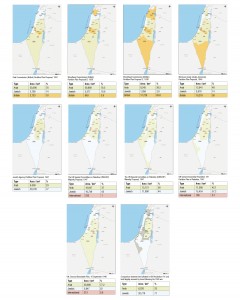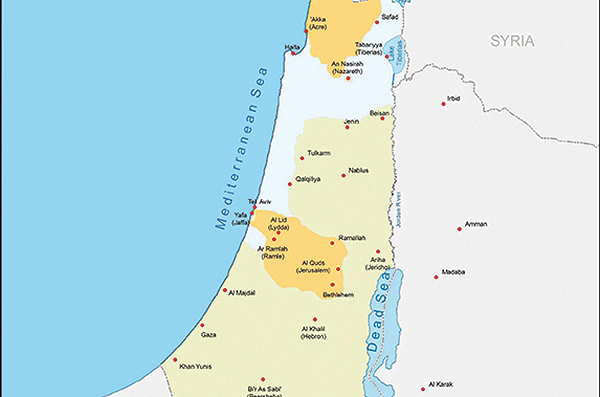 Starting in the 1920s, there was increased resistance among Palestinians against the British Mandate occupation and its increasingly Zionist tendencies, that in 1936 led to the outbreak of a revolt. (Map 1) The Peel Commission was appointed by the British government in 1936 to find a solution in face of the increasing unrest and suggested a plan for the partition of the country. (Maps 2 & 3) The Woodhead Commission followed in 1938, ostensibly to further examine and revise the Peel Commission partition plan, but in fact with the intention of rendering partition as unfeasible – which it fulfilled and justified with a number of reasons. Palestinians refused the partition plans, citing that the coastal areas were most fertile; they produced the vast majority of all citrus production, the main export asset at the time. During the unsuccessful revolt of 1936-9, over 10% percent of the Arab male population aged between 20 and 60 was killed, wounded, imprisoned, or exiled,i (which impacted on the outcome of the war in 1948.) (Map 4) In 1946, after WWII, with an increased influx of Jewish immigrants, the situation of the British Mandate became untenable. A commission headed by Herbert Morrison (Britain’s Labour government) and Henry Grady (United States) drew up a plan that suggested semi-autonomous Palestinian and Jewish regions, leaving the British high commissioner in control of defense, foreign relations, customs, and immigration. The plan was rejected by Palestinians and Jews.ii (Map 5) The Jewish Agency submitted a partition plan in 1947 that among the plans of the time left the least amount of territory to Palestinians. The situation today most resembles this plan. (Maps 6-7) UNSCOP submitted two proposals that attempted to divide the country according to demographic concentrations – which proved impossible since the Palestinian and Jewish populations were too intertwined. (Map 8) In 1947, the UN adopted with Resolution 181 a plan that allocated for Jews 55% of the country, including of the two port cities of Tel Aviv/Jaffa and Haifa, the Sea of Galilee, and the resource-rich Negev – even though they comprised only a third of the country’s population (608,225 out of 1,845,559)iii and owned only about 7% of the land.iv In the area allocated to the Jewish state, only about 57% of the population was actually Jewish (538,000 Jews, 397,000 Arabs).v The Jewish community accepted the UN Partition Plan; the Palestinians (except members of the Communist Party) and the Arab countries rejected it. (Map 9) Sent by the UN, Count Folke Bernadotte proposed two plans, which included reciprocate recognition of a Jewish and an Arab state, that was rejected by both Arabs and Jews; the count was assassinated by members of a Jewish underground group. (Map 10) By the end of the 1948 war – called the War of Independence by Israel and the Naqba (Disaster) by the Palestinians – Israel controlled 77% of the country, including half the territory that the UN had allocated to Palestinians. Some 750,000 Palestinians who had been living in what became Israel were made refugees or internally displaced people, and only 100,000 were able to remain in their homes. More than 418 villages, two-thirds of the villages of Palestine, were systematically destroyed by Israel after their residents had fled or been driven out.vi The Arab areas, now reduced to 23% of original Palestine,vii were taken over by Jordan (West Bank) and Egypt (Gaza). The 1949 Armistice Line, today known as the Green Line, has de facto demarcated the State of Israel until today. Since 1988, when the Palestinians recognized Israel within that boundary,viii it has constituted the basis of the two-state option in which the Palestinians claim a state on all the lands conquered by Israel in 1967: the West Bank, East Jerusalem, and Gaza.
Starting in the 1920s, there was increased resistance among Palestinians against the British Mandate occupation and its increasingly Zionist tendencies, that in 1936 led to the outbreak of a revolt. (Map 1) The Peel Commission was appointed by the British government in 1936 to find a solution in face of the increasing unrest and suggested a plan for the partition of the country. (Maps 2 & 3) The Woodhead Commission followed in 1938, ostensibly to further examine and revise the Peel Commission partition plan, but in fact with the intention of rendering partition as unfeasible – which it fulfilled and justified with a number of reasons. Palestinians refused the partition plans, citing that the coastal areas were most fertile; they produced the vast majority of all citrus production, the main export asset at the time. During the unsuccessful revolt of 1936-9, over 10% percent of the Arab male population aged between 20 and 60 was killed, wounded, imprisoned, or exiled,i (which impacted on the outcome of the war in 1948.) (Map 4) In 1946, after WWII, with an increased influx of Jewish immigrants, the situation of the British Mandate became untenable. A commission headed by Herbert Morrison (Britain’s Labour government) and Henry Grady (United States) drew up a plan that suggested semi-autonomous Palestinian and Jewish regions, leaving the British high commissioner in control of defense, foreign relations, customs, and immigration. The plan was rejected by Palestinians and Jews.ii (Map 5) The Jewish Agency submitted a partition plan in 1947 that among the plans of the time left the least amount of territory to Palestinians. The situation today most resembles this plan. (Maps 6-7) UNSCOP submitted two proposals that attempted to divide the country according to demographic concentrations – which proved impossible since the Palestinian and Jewish populations were too intertwined. (Map 8) In 1947, the UN adopted with Resolution 181 a plan that allocated for Jews 55% of the country, including of the two port cities of Tel Aviv/Jaffa and Haifa, the Sea of Galilee, and the resource-rich Negev – even though they comprised only a third of the country’s population (608,225 out of 1,845,559)iii and owned only about 7% of the land.iv In the area allocated to the Jewish state, only about 57% of the population was actually Jewish (538,000 Jews, 397,000 Arabs).v The Jewish community accepted the UN Partition Plan; the Palestinians (except members of the Communist Party) and the Arab countries rejected it. (Map 9) Sent by the UN, Count Folke Bernadotte proposed two plans, which included reciprocate recognition of a Jewish and an Arab state, that was rejected by both Arabs and Jews; the count was assassinated by members of a Jewish underground group. (Map 10) By the end of the 1948 war – called the War of Independence by Israel and the Naqba (Disaster) by the Palestinians – Israel controlled 77% of the country, including half the territory that the UN had allocated to Palestinians. Some 750,000 Palestinians who had been living in what became Israel were made refugees or internally displaced people, and only 100,000 were able to remain in their homes. More than 418 villages, two-thirds of the villages of Palestine, were systematically destroyed by Israel after their residents had fled or been driven out.vi The Arab areas, now reduced to 23% of original Palestine,vii were taken over by Jordan (West Bank) and Egypt (Gaza). The 1949 Armistice Line, today known as the Green Line, has de facto demarcated the State of Israel until today. Since 1988, when the Palestinians recognized Israel within that boundary,viii it has constituted the basis of the two-state option in which the Palestinians claim a state on all the lands conquered by Israel in 1967: the West Bank, East Jerusalem, and Gaza.
Maps courtesy of ARIJ. Caption by Michael Younan.
i. Rashid Khalidi, The Iron Cage, Oneworld Publications, Oxford, pg 107-8.
ii. http://www.encyclopedia.com/doc/1G2-3424601875.html.
iii. Official Records of the Second Session of the UN General Assembly, http://domino.un.org/unispal.nsf/9a798adbf322aff38525617b006d88d7/07175de9fa2de563852568d3006e10f3?OpenDocument.
iv. The Jerusalem Fund, http://www.thejerusalemfund.org/ht/d/ContentDetails/i/2963.
v. Jewish Virtual Library, http://www.jewishvirtuallibrary.org/jsource/History/partition_plan.html.
vi. For a full list, go to Palestine-Israel Journal at http://www.pij.org/details.php?id=224
vii. Palestine Link, http://www.palestinelink.eu/palestine/timeline/1940-1949/
viii. Hussein Ibish, “How many times must the Palestinians recognize Israel?”, Haaretz, Mar 3, 2014.


